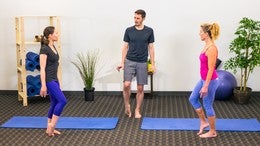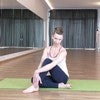Description
Brent starts with a lesson about the anatomy of the feet. The movement portion of the class begins at 6:19.
About This Video
Transcript
Read Full Transcript
Hello Brent Anderson here and another Palladio's anytime lecture and class. And I wanted to talk to you today about how we can get our feet to be happier. And I thought before I start with the class that I'd share a little lesson about the foot. We'll look at the skeleton and we'll look at a live foot and then we'll get right into the class and hope you join us and that your feet are as happy as our feet at the end of the class. You know, when we look at the skeleton of the foot, um, a lot of times I like to remind people that it's almost like we have two sides of the foot. We often refer to the medial foot, which is going to be the first, the second and the third ray. And it has its articulation that comes into the medial foot and into what's called the Taylors and the tailors bone articulates with the Tibia, which is our, is our a t tib fib joint, right? So the ankle joint.
So if I grab the medial part of the foot, it actually has an axis like this that it rotates through up into the ankle. And so that is going to be the pronation and supination of the foot. So when it rolls in towards the middle line, that's going to be the pronation and when it rolls out, it's going to be the super nation of the foot. Now the second part of the foot is called the lateral foot and that's the fourth and the fifth ray. And they articulate with the, with the cuboid and with the calcaneus and its movement is going to be inversion and eversion. So that's often when we look from the back of the foot and ankle and we see the hill moving in relationship to the Tibia and the fibula.
So just to reiterate the medial part of the foot, right? One, two, and three. When they rotate, that's going to be pronation and supination of the foot. You probably hear these terms a lot and the lateral part of the foot is inversion [inaudible]. Now, the reason why I bring this up is because a lot of times people say, oh, your foot is pronated. Oh, your foot of supinated. You need the special kind of shoe to work with. The reality is we want our foot to be able to pronate and supinate.
That's a very normal feature. So one of things we're going to be working on in the class is that when we end up in mid stance, that's when we're standing up right on top of our foot. What we expect is that the medial foot is going to go into a little bit of pronation and come down the floor and the lateral foot is going to go into a little bit e version, bringing it into the force. So the foot splays and widens into the ground to give us lots of support. When we're in mid stance, as we start to roll forward on our foot, as we're towing off and getting off the ground, we're going to roll back over towards that second toe, and that's going to put us into a super nation.
So that foot's gonna come up this way. And the hind going to go into an inversion that makes the foot rigid and allows us to toe off and propel. So that's how we walk. That's how we run with our feet. So it's very important that our feet are dynamic, that there are mobile, that the toes are agile and that's going to be the purpose of this class. So what I want to do now is bring a real foot up so I can share that with you.
I'll be right back with a real person. So now I have Megan with me and we're getting ready to look at a real human foot and I want you to see what it looks like with real muscles, tendons, and flesh and skin on top of it so that you can see how it moves and what it should look like when we're grabbing our partner's foot in the class, which we are going to do. Now you might be grossed out by feet, but I love feet and the gross of the feet the better. So here we go. Um, Megan as nice, clean feet, we made sure she cleaned them before the video. Shoot. So that you guys can appreciate her beautiful toenail Polish. But if you think of what I said earlier on the skeleton, the first three toes, their rays come up into the tailors. That is the main bone that makes up the ankle joint between the Tibia and Tibia and fibula. And so when I think of movement of this part of the foot, it's going to be pronation and supination, pronation and supination.
So when Megan puts pressure down on the ground, the foot is going to naturally go into pronation as some people think that's bad. I hear people say, Oh, they're looking at somebody's posture in a static position. And they're like, oh my gosh, you have pro nation. It's like, yes, you're in mid stance. You have pro nation's a little different than flat feet, but we should have flatter feet when we stand up on it than not. The second part of that foot we talked about was the fourth and the fifth toe and the metatarsal is that go with them and they connect into the hill bone or the cow canus. And this is where we get inversion eversion of the foot. So we get a little better movement in Megan than we did in the skeleton thing.
Goodness. It's always better to move better than a skeleton. And with that motion there, that's going to be the inversion e-version. So again, we said that when we're in mid stance, if Megan was to stand here on top of my foot, what's going to happen is the foot's going to splay a little bit in that the lateral foot is going to open up into its inversion eversion and the medial foot is going to open up a little bit into its pronation. So it's going to flatten and widen out for stance mobility. As she starts to toe off in her motion, the foot's going to roll into a little bit of super nation and inversion in the foot becomes very rigid so that she can toe off, run, jump, walk through that motion. So let's see. I don't know if you can see that or not, but again, as she toes off in that foot starts to plantarflex is going to go into a little bit of sickling, right?
We call that in the dance world and we're going to get a little bit of super nation. That foot gets really rigid and now it can push her off the ground or she's going to be jumping, running, dancing, walking, et cetera. Okay, so with that understanding, we're going to start our class. We'll be right back. Stay tuned. We're going to get you moving your foot and have happy feet in a few minutes. Hey, welcome back. It's time to get our feet nice and happy. Um, hopefully you watched the PR, the precursor there to look and learn a little bit about foot anatomy, both in the skeleton, also with Megan's cute foot with a toenail Polish.
So now we're going to go and what I want you to do first is we're just going to grab our own foot. So you're going to grab your foot, cross the right leg over. And what I want you to just appreciate and put your finger in between the big toe and sort of wrap it around like the thumb. Put your other hand across the front of the foot and just doing little tiny circles with the big toe and opening that area up. And a lot of times what happens is we put our feet in shoes and we forget about them and they just stay there in these shoes. But we don't realize how Dexter areas, our feet can be right.
So we're just gonna wake them up and I want you to think of like a little child's foot. If you ever, you guys have some little children, um, but little children's feet in how supple they are and you can just turn them and move them in any direction, right? We don't want to lose that dexterity. You like to have that x charity and then take your pincher grip and grab the second metatarsal head there and just sort of flex it and extended. And you can do little circles around it and massage in that joint. So if you were to see it when I bend the knuckle, you can see the knuckle jumping up. That's the area that you're pinching. And with those fingers and the thumb and just sort of massaging that.
And then we go down to the third toe. This is the little piggy that had none.
You're going to grab the lateral foot and just take that and pull it towards you and away from you, right? You're gonna move the whole ankle. And then we're going to do a little circle with that. So we're going to circle the foot from that grip that's going to mobilize the lateral part of the ankle, the lateral part of the foot. This is the inversion e version, part of your foot and ankle. And then reverse that circle.
And trying to prevent them. Keep the movement. I saw commercial last night on TV of this thing that cures all Bunyan's as a strap on the foot and it just pulled the toe out to the side and I was like, I'm sure that's going to cure your Bunyan's. But um, if we keep them nice and healthy from the beginning, so do this with your kids. Teach them how to love their feet. And then we go to the second toe pincer grip, a little massage in forward and back circles.
And then we're going to grab that lateral foot.
So you didn't get a little more movement in there. I heard that you get extra Brownie points for snap crackles and pops. Good. Now the next thing need to do is just putting the foot in front of you and put your thumb right in that little softness.
I just lost control of it. You go ahead and slow it back down
The Gabe does all day long different sequences and relax. Lacks good. Let's have you put the blanket back so that your heads on it, you're going to lay on your backs. All right, so now in this position, bring your legs up in the air. Shane grabbed the back of your knees. All right. In that position I want you to point in, flex the ankles and I'll call it out. Point. Flex point. Flex point, flex point, flex point, flex point, flex a little bit faster. And point flex, flex this.
Go as fast as you can. Point, point, point, point, point, point, point. Turn your legs out. So feet turned out and point, point, point, point, point, point. There'll faster pull back those tools work at all the way through and now alternate it, right, left, right, left, right, left, right, left, left, go parallel, right, left, right, left. Keep going, go until it burns a little bit faster. Dah, Dah, Dah, Dah, Dah, Dah, Dah, Dah, Dah, Dah, Dah. Pull the toes back til the toes back. Keep going and relax. That's an exercise we do before you go running because what it does, it warms up all the tissues around the Tibia.
So those of you that have a trouble with things like uh, stress fractures or Shin splints, that's a fantastic warmup for you at home. So let's bring it back up. Now in the sitting position, and we're going to take the ball, I'm going to place the ball underneath the arch of the foot. And at first just let it just sort of sit there, right? You're just going to have the weight in the ball and just find the most tender spot in the arch of your foot. And as you sit there and don't push it too hard to sort of find that spot and just let the foot soften around it like it's gonna melt around that ball and then place your hands on that knee.
If you can coordinate that and put a little bit of weight into that same spot, just through your hands and your arms. Taking a deep breath. Now from here, same position. Just curl the toes down and lift the toes up. Don't change anything else. Curl the toes down and lift the toes up.
Curl the toes down. Oh one more time. Down and up. Changed the point in the foot. Take it a little bit further back towards the hill. Same thing. Get the weight into it, settled into that. Take the toes down. So those of you that are dealing with things like plantar fasciitis or tendonitis in the foot, tendinosis, again, just getting the tendons to move and you need to make the muscle contraction for this to work. If you just do it passively and put pressure in it, you're going to miss the boat on this.
You're not going to get the full effect of getting that mobility and those tendons and really try to curl the toes underneath and really try to open and spread the toes up on top and down and curl and up and open. Keeping the heel down on the ground. One more time. And then let's switch our feet center of the foot. Find that tender spot. There's mine. Yup. And then put the weight through it.
It might be a little tender in there, but just listen to your body. Just too much. Ease up some of the weight and that movement in there and then relax. Take the ball away and with our feet in front of us and let's set it back on top of your blankets so you have a little more height. Makes it a little bit easier. And let's start with a little piano playing with our feet.
So trying to use just the toes. We're going to go from the little toe to the big toe, rolling the toes in. If you need to use your fingers, you can use your fingers too. Sometimes that helps out and try to make it more about the toes and less about the knees. Sometimes we go like this. It's really about getting the toes to work.
Slow it down and see if you can get just each toe a chance to come down. Then let's reverse it. Go from the big two out to the little toe. All right, now here's the fun part. Let's take one foot at a time, unreached down, but fingers on the second, third, fourth, and fifth toe, and just lift up the big toe
See if you get those middle three toes to come up and down without using the big toe or the little toe pushing into the floor and relaxed, not a work switch steps. Here we go. Holding down the four toes, lift the big toe up
And we're just going to put a little bit of weight into it. Yeah, a little bit of stress or trying to point the foot up on top of it. Yeah. Ah, and then we're going to switch that around. Now the mat better. I'm going to use this blanket so I don't damage my toe. All right? But we get the big toe underneath. Don't try to stand up on it. All right. Break your toe. I'm not sure.
A ballet dancer and then switch feet. So we start with the big toe outs and what I noticed is when you do the other exercises first, what happens is this all of a sudden becomes a whole lot easier. So a lot of times when we do our run at t exercises and happy feet exercises, we used to just do them all in standing. But it was sorta hard to do them in standing when you couldn't get any mobility in them in the back beginning. So now get the other big toe down and separate them. Try and get the toes as long as you can. We just practice that, get the ankle to open up.
And it's hard not to do these. Once you learn them, you're going to want to do them all the time. Keep those toes happy and healthy and relax. That's good. Now let's stand on the wood. And I'm going to move this back a little bit. So just stand on the wood and now let's just feel our feet.
So we're gonna finish up with just being aware of our feet and the floor now and the information that they're giving to our body. So with your eyes closed, imagine that you are your own skeleton and that's you're suspended from the ceiling with a very heavy elastic band. So your skeletons just hanging down. Very comfortable. And notice where the weight is in the bones of your feet and just appreciate that for a second. And notice, is the weight in the middle of your foot, is that on the ball of the foot? Is it to the outside of the feet? Is it different for each foot, which it might be? And then imagine that a wind from behind you is blowing you forward into the ball of the foot.
And notice when the toes engage and when the body recoils and comes back up into its center. Let's try that a couple times. The wind blows the body forward, fill the toes, engage into the floor, and then come back to center. And then now imagine the wind blowing from the front lawyer's back onto our heels and pay attention to how the foot turns in or turns out on those axes that we were playing with and come forward. So you'll notice that when the body weight goes back, we go into a little bit of super nation and we go forward. It goes into pronation. If we go further onto our toes, it goes back into super nation. So you can sort of notice that transition through our feet of going from super nation and virgin to pronation.
E-Version back to super nation version as we sort of move up. And that'll be something that we're going to leave the Madeline black to talk about this week as she comes in and talks to you about gait. Now take the weight and shift it to the left of both feet. Shift the weight to the right of both feet. And again here we're sort of playing with those rotatory axes of the foot, the medial and lateral foot. So if your put your weight to the right side, we have protonated the left foot and supinated the right foot.
If we shift our weight to the left side of both feet, we have now supinated the left foot and pony the right foot. So without thinking about it too much, just appreciate shifting the weight back and forth right to left and what's going to be the result of this as we wake up all this proprioception in the foot and night. I forgot to mention earlier that there was a study recently done where it locked down and said, even when we wear a sock and a mess, especially imagine for standing on a mat that it decreases our ability for proprioception significantly. So the practice is actually as as best to be on a hard surface like this wood floor or a concrete polished floor in your studio's barefoot. Even a sock would decrease that movement.
Now let's finish up going into circumduction full circles all the way around the foot. And again, just waking up and appreciate all those things we learned and all the trigger points we touched in the foot. And notice how much easier it is to shift the weight around the ankles and then go back the other direction. So reversing that circle being ever so conscious of when the toes engage, when the toes disengaged, when the foot pronates or supinate. It's appreciate that movement and notice also how it affects the rest of your body. Come back into the center of your line. Imagine that elastic band pulling us up, taking a deep breath and just notice now the position on your feet, the weight bearing, and notice how the body wants to be leaning just a little bit forward at the ankle. So you have that nice four lane.
All of you are in a beautiful position right now and notice how the muscles around the hip, the buttocks, the thigh, the knee can actually relax all because your feet are awake and they're mobile and they're doing their job of feeling the earth, giving us security, giving us what we call happy feet. Open your eyes. Thank you for joining me for a half hour of happy feet. May your feet be happy and we'll see you the next time on. [inaudible] anytime.
Comments
You need to be a subscriber to post a comment.
Please Log In or Create an Account to start your free trial.

































